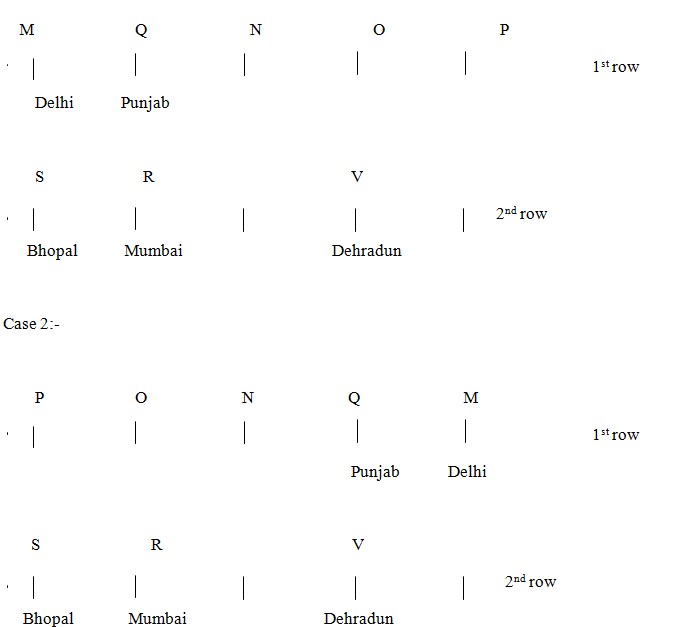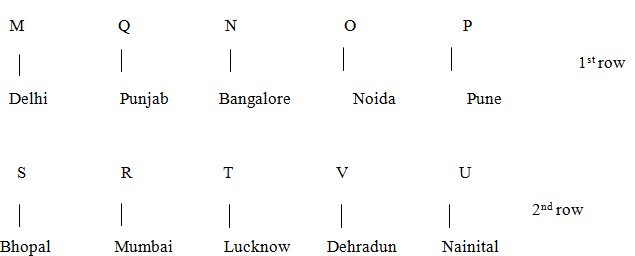Question
Four of the following five are alike in a certain way
based on the given arrangement and hence form a group. Who among them does not belong to that group? Study the following information carefully to answer the given questions:- There are ten family members M, N, O, P, Q, R, S, T, U, V. They like different cities i.e. Delhi, Bangalore, Mumbai, Bhopal, lucknow, Dehradun, Nainital, Pune, Punjab and Noida but not necessarily in the same the same order. They are sitting in two parallel rows containing five members each, in such a way that there is an equal distance between adjacent persons. In row 1 – M, N, O, P, Q are seated (not necessarily in the same order) and all of them are facing south. In row 2- R, S, T, U, V are seated (not necessarily in the same order) and all of them are facing north. Members of row 1 are sitting ahead (towards north) of the members of row 2. Therefore in the given seating arrangement each member seated in row 2 faces the back of the other member of row 1. All of them have relation with each other. Only one member sits between O’s sister and M’s brother. Neither N nor U’s grandfather sits just opposite to U. S likes Bhopal and N likes neither Delhi nor Noida. Only two members sit between O’s father and U’s father. U’s husband, who likes Dehradun, sits third to the right of U’s uncle. R sits second to the left of U’s husband. M has two sons and one daughter. Q is the grandmother of R and U. P is the brother – in – law of Q. O is the father of R and brother of N. R’s grandfather, who likes Delhi is not an immediate neighbour of N. The member who sits just opposite to U’s brother, who likes Mumbai, sits immediate left of M’s daughter. V is the husband of U and brother of the one, who likes Lucknow. U likes Nainital and Q likes Punjab. O likes neither Pune nor Bangalore. T likes Lucknow. P does not like BangaloreSolution
Now for sitting arrangement – Only one member sits between O’s sister and M’s brother. Only two members sit between O’s father and U’s father. U’s husband, who likes Dehradun, sits third to the right of U’s uncle. R sits second to the left of U’s husband. The member who sits just opposite to U’s brother, who likes Mumbai, sits immediate left of M’s daughter. R’s grandfather, who likes Delhi, is not an immediate neighbour of N. U likes Nainital and Q likes Punjab. From these conditions there will be two cases: Case 1:-  Now Neither N nor U’s grandfather sits just opposite to U. As there will be no place left for U in case 2. So case 2 will be eliminated. From rest U likes Nainital and Q like PUNJAB. O likes neither Pune nor Bangalore. T likes Lucknow. P does not like Bangalore. So the final solution is –
Now Neither N nor U’s grandfather sits just opposite to U. As there will be no place left for U in case 2. So case 2 will be eliminated. From rest U likes Nainital and Q like PUNJAB. O likes neither Pune nor Bangalore. T likes Lucknow. P does not like Bangalore. So the final solution is – 
Which state government has announced monthly pension for the Padma awardees of the state?
Who was appointed as the interim MD & CEO of Bandhan Bank effective from July 10?
Recently Manik Shah was appointed the new CM of which state?
...How many village panchayats in Surajpur district, Chhattisgarh, were declared “Child Marriage-Free” on 17 September 2025?
Which Indian Industrialist occupied the ninth rank globally in Hurun Global Rich List 2022?
Consider the following statements about Mohenjo Daro:
1. Archaeologists recently discovered 2000-year-old copper coins in this area.
The first National Handloom Day in India was celebrated in which city?
Which capital city became the fourth in the Northeast to get railway connectivity in 2025?
Which Indian bank is collaborating with India Exim Bank to bridge the trade finance gap in Africa?
Which festival is famous in Andhra Pradesh?
Relevant for Exams:



